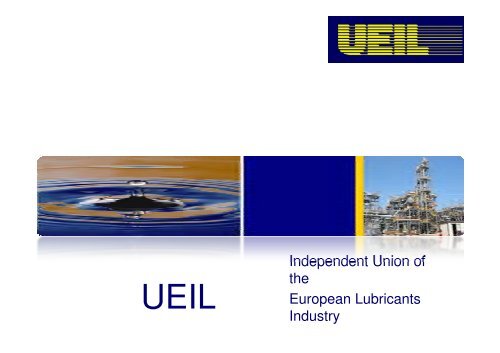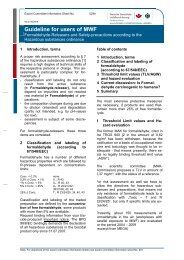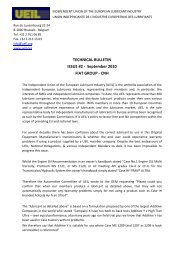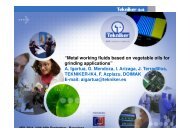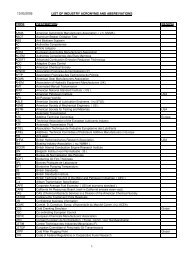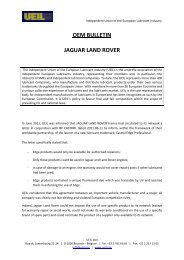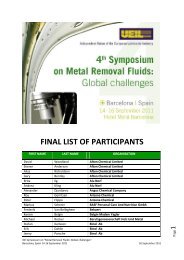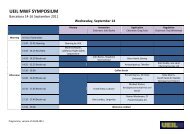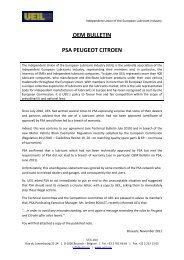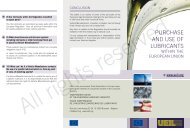ACEA 2008 Sequences - UEIL
ACEA 2008 Sequences - UEIL
ACEA 2008 Sequences - UEIL
Create successful ePaper yourself
Turn your PDF publications into a flip-book with our unique Google optimized e-Paper software.
<strong>UEIL</strong><br />
Independent Union of<br />
the<br />
European Lubricants<br />
Industry
<strong>ACEA</strong> <strong>2008</strong> <strong>Sequences</strong><br />
June 2009
<strong>ACEA</strong> <strong>2008</strong> sequences<br />
• <strong>ACEA</strong> requires that engine performance testing used to support a<br />
claim of compliance with these <strong>ACEA</strong> sequences should be<br />
generated according to the European Lubricants Quality<br />
Management System (EELQMS), but <strong>ACEA</strong> reserves the right to<br />
define alternatives in exceptional cases.<br />
• Compliance with the ATIEL Code of Practice is mandatory for any<br />
claim to meet the requirements of the <strong>2008</strong> issue of the <strong>ACEA</strong><br />
sequences. Therefore <strong>ACEA</strong> requires that claims against the <strong>ACEA</strong><br />
oil sequences can only be made by oil companies or oil distributors<br />
who have signed the EELQMS oil marketers’ Letter of Conformance.<br />
For details visit www.atiel.org
<strong>ACEA</strong> <strong>2008</strong> sequences<br />
New engine technologies for passenger cars and heavy duty trucks<br />
have defined new requirements for lubricants and have forced the<br />
development of new specifications.<br />
Changes in <strong>ACEA</strong> <strong>2008</strong> sequences are the most important since<br />
<strong>ACEA</strong> was created in 1996. These new requirements will require<br />
many re-formulations, especially for passenger cars (A/B and C<br />
sequences).<br />
<strong>ACEA</strong> <strong>2008</strong> has been in place since December 22 nd <strong>2008</strong><br />
• After December 22 nd 2009, all new formulations must meet <strong>ACEA</strong> <strong>2008</strong><br />
requirements.<br />
• After December 22 nd 2010, it will not be possible to claim performance<br />
according to <strong>ACEA</strong> 2007.
<strong>ACEA</strong> <strong>2008</strong> sequences<br />
Passenger cars<br />
Conventional technology: A/B categories<br />
• New BN limits<br />
• BN ≥ 8 for A/B categories<br />
• Enhanced performance in the control of gasoline sludge<br />
• M111SL engine test : Engine Sludge ≥ RL 140+4σ or > 9.0 for all<br />
categories except A1/B1-08<br />
• Enhanced performance in diesel piston deposits<br />
• VW DI engine test : Piston cleanliness ≥ RL 206-4 for A1/B1-08 and<br />
A3/B3-08<br />
• VW DI engine test : Piston cleanliness ≥ RL 206 for A3/B4-08 and<br />
A5/B5-08<br />
• Upgrade in performance for diesel wear<br />
• OM 646LA engine test replace OM 602A<br />
• Need to adapt to biofuels used in light duty diesel powered vehicles. EN<br />
590 allow 5% FAME with conventional diesel (B5) – OM646LA test
<strong>ACEA</strong> <strong>2008</strong> sequences<br />
Passenger cars<br />
Low SAPS technology: C categories<br />
• Enhanced performance in the control of gasoline sludge<br />
• M111SL engine test : Engine Sludge ≥ RL 140+4σ or > 9.0<br />
• Upgrade in performance for diesel wear<br />
• OM 646LA engine test replace OM 602A<br />
• Need to adapt to biofuels used in light duty diesel powered<br />
vehicles. EN 590 allow 5% FAME with conventional diesel (B5) –<br />
OM646LA test<br />
• Enhanced fuel economy based on M111FE engine test<br />
• 3,0 % min for <strong>ACEA</strong> C1-08
<strong>ACEA</strong> <strong>2008</strong> sequences<br />
Passenger cars<br />
A1/B1-08 A3/B3-08 A3/B4-08 A5/B5-08 C1-08 C2-08 C3-08 C4-08<br />
HTHS 2.9 to 3.5 ≥ 3.5 ≥ 3.5 2.9 to 3.5 ≥ 2.9 ≥ 2.9 ≥ 3.5 ≥ 3.5<br />
Volatilité Noack, % ≤ 15 ≤ 13 ≤ 13 ≤ 13 ≤ 13 ≤ 13 ≤ 13 ≤ 11<br />
Cendres sulfatées ≤ 1.3 ≤ 1.5 ≤ 1.6 ≤ 1.6 ≤ 0.5 ≤ 0.8 ≤ 0.8 ≤ 0.5<br />
Soufre, % poids report report report report ≤ 0.2 ≤ 0.3 ≤ 0.3 ≤ 0.2<br />
Phosphore, % poids report report report report ≤ 0.05 0.07 to 0.09 0.07 to 0.09 ≤ 0.090<br />
BN, mgKOH/g ≥ 8.0 ≥ 8.0 ≥ 8.0 ≥ 8.0 - - ≥ 6.0 ≥ 6.0<br />
TU5JP ≤ 0,8*RL216 ≤ 0,8*RL216 ≤ 0,8*RL216 ≤ 0,8*RL216 ≤ 0,8*RL216 ≤ 0,8*RL216 ≤ 0,8*RL216 ≤ 0,8*RL216<br />
Sequence VG Pass Pass Pass Pass Pass Pass Pass Pass<br />
TU3M scuffing Pass Pass Pass Pass Pass Pass Pass Pass<br />
M111SL - AES ≥RL140<br />
≥RL140+4σ<br />
or >9.0<br />
≥RL140+4σ<br />
or >9.0<br />
≥RL140+4σ<br />
or >9.0<br />
≥RL140+4σ<br />
or >9.0<br />
≥RL140+4σ<br />
or >9.0<br />
≥RL140+4σ<br />
or >9.0<br />
≥RL140+4σ<br />
or >9.0<br />
M111FE ≥ 2.5 - - ≥ 2.5 ≥ 3.0 ≥ 2.5 ≥ 1.0 xW-30 ≥ 1.0 xW-30<br />
DV4TD Pass Pass Pass Pass Pass Pass Pass Pass<br />
OM602A<br />
grandfathering<br />
allowed<br />
Test removed Test removed Test removed Test removed Test removed Test removed Test removed<br />
OM646LA - Cam wear outlet ≤ 140 ≤ 140 ≤ 120 ≤ 120 ≤ 120 ≤ 120 ≤ 120 ≤ 120<br />
TDI - Piston cleanliness<br />
Ring sticking (average)<br />
End of test BN<br />
≥ RL206 - 4<br />
≤1,2<br />
≥ 4<br />
≥ RL206 - 4<br />
≤1,2<br />
≥ 4<br />
≥ RL206<br />
≤1,0<br />
≥ 4<br />
≥ RL206<br />
≤1,0<br />
≥ 4<br />
≥ RL206<br />
≤1,0<br />
report<br />
≥ RL206<br />
≤1,2<br />
report<br />
≥ RL206<br />
≤1,0<br />
report<br />
≥ RL206<br />
≤1,0<br />
report
<strong>ACEA</strong> <strong>2008</strong> sequences<br />
Heavy duty trucks<br />
<strong>ACEA</strong> E2 category has been withdrawn.<br />
BN limits have been defined for each category.<br />
• BN ≥ 12 for E4-08, BN ≥ 9.00 for E7-08, BN ≥ 7 for E6-08 & E9-08<br />
New engine tests have been put in place:<br />
• OM 646LA replace OM 602A<br />
• OM 501LA replace OM 441LA<br />
• Mack T-12 replace Mack T-10<br />
• Cummins ISM replace Cummins M11 HST / M11 EGR<br />
Need to adapt to biofuels used in light duty diesel powered<br />
vehicles. EN 590 allows 5% FAME with conventional diesel (B5)<br />
– OM646LA and OM501LA tests<br />
New category: <strong>ACEA</strong> E9-08<br />
• SAPS limits are identical to API CJ-4 specification. For DPF, EGR and<br />
SCR equipped engines using low sulphur fuel.
<strong>ACEA</strong> <strong>2008</strong> sequences<br />
Heavy duty trucks<br />
E4-08 E6-08 E7-08 E9-08<br />
Sulfated ash, % ≤ 2,0 ≤ 1,0 ≤ 2,0 ≤ 1,0<br />
Phosphorus, % - ≤ 0,08 - ≤ 0,12<br />
Sulfur, % - ≤ 0,3 - ≤ 0,4<br />
BN, mg KOH/g ≥ 12 ≥ 7 ≥ 9.00 ≥ 7<br />
Oxidation (PDSC) - - ≥ 65 ≥ 65<br />
OM 501LA (OM 441LA)<br />
OM 646LA (OM 602A)<br />
Mack T-8E<br />
Mack T-11<br />
• Cam Wear Outlet<br />
Mack T-12 (Mack T-10)<br />
Mack T-12<br />
Cummins ISM (Cummins M11)<br />
Cummins ISM<br />
(MB 228.5)<br />
(≤ 140)<br />
(MB 228.51)<br />
(≤ 140)<br />
(API CH-4) (API CH-4)<br />
(API CI-4)<br />
(MB 228.3)<br />
(≤ 155)<br />
(API CH-4)<br />
(API CI-4)<br />
(API CI-4)<br />
(MB 228.31)<br />
(≤ 155)<br />
(API CJ-4)<br />
(API CJ-4)<br />
(API CJ-4)


